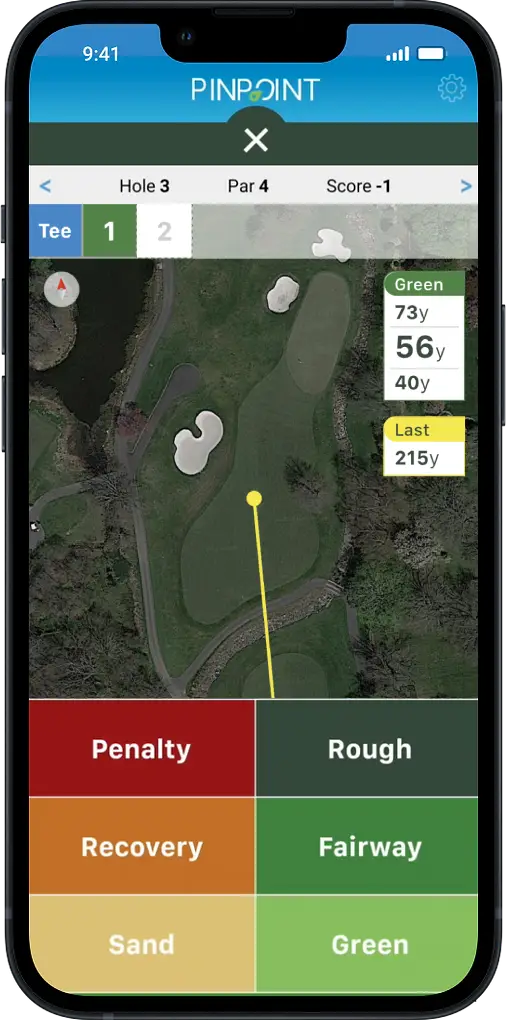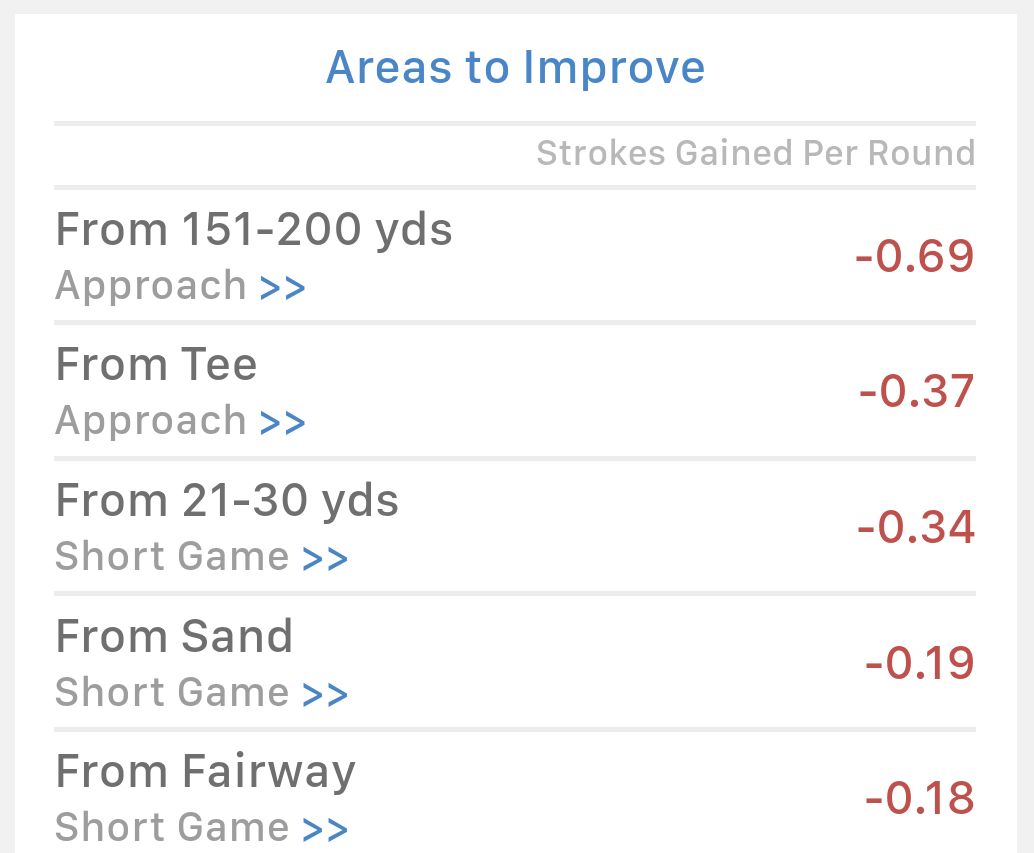Think your bladed 60-degree lob wedge shot from last Saturday is the sole culprit of your mediocre short game? Think again.
The short game is anything but short when it comes to complexity.
Many golfers remain clueless about which aspects of their short game need refining.
So what do they do? They head to the chipping green with a bucket of balls, their 56 degree wedge, and start hitting the same 15-25 yard shot over and over again.
If this rings true, let us offer a truly transformative solution for your short game.
Understanding the Problem
Everyone hits some bad shots, and everyone hits some good shots. It’s not enough to know which areas occasionally result in embarrassment, like a chunked wedge or a ball left in the bunker.
Ideally, you’ll want to fully assess each shot, and aggregate the data about all your shots to build a clear picture of where you succeed and where you struggle.
Consider the distance: are you better from 10 yards than 30 yards? Then consider the turf: is your problem exclusive to the rough, or does the fairway pose problems too?
But more importantly, how do you know what’s a problem and what’s just a difficult shot? If you hit a 15-yard bunker shot to 10 feet, was that good? Are you good at 15-yard bunker shots in general?
Traditional metrics like up-and-down rates, greens in regulation, and putt counts don’t give you enough information to fully understand your short game. But strokes gained does.
Strokes Gained and Short Game Analysis
To understand your short game in detail, you need a definitive baseline for each shot. Strokes gained provides that point of comparison.
If you’re not totally clear on how strokes gained works, check out our two part series, What is Strokes Gained and How Strokes Gained Works. Then come back and finish this article. We’ll wait!

Step 1: Track At Least Three Rounds of Golf
Using the Pinpoint Strokes Gained App, track three rounds of golf, so you have enough shots to see the trends. You can input your ball locations and lies as you play, or you can put them in after the round. Either way, it only takes about 5 minutes per round and gathers all the data you need for the complete analysis.
Set your target handicap within about five shots of your current handicap. In other words, if you are a 20 handicap player, don’t set your Pinpoint app to compare you to a scratch golfer; that’s too much information to take in right now.
Step 2: Analyze the Data
After a few rounds of golf, here are some of the things that you are going to want to look for:
Overall Short Game Strokes Gained
The overall strokes gained for the short game will give you one number that represents your short game. If that number is great, keep doing what you’re doing. If it ain’t broke, don’t fix it!
Breakdowns by Distance and Lie
On the “Short Game” page within Pinpoint, you can dive into breakdowns by distance and lie, to see exactly where you’re strong and where you’re struggling. This is the place to see if fairways or bunkers are causing those low strokes gained numbers.
With the distance breakdown, you can see your precise performance down to 10-yard increments. You may find that from 11-20 yards away, you’re losing one stroke per round. But from 21-30 yards away, you’re gaining half a stroke. Remember our example of hitting a bucket full of 25-yard shots? The data shows you’ve got more pressing concerns!
Areas To Improve
Finally, take a look at Pinpoint’s general “Areas to Improve”. This is where Pinpoint gives you recommendations across all your recent rounds across all areas of your game.
In the areas to improve, Pinpoint will highlight specific problem spots, like short fairway chips, or longer bunker shots.
Remember, each type of shot is compared to your baseline player. You may not even intuitively feel like you’re struggling with a certain shot, but if the strokes gained is negative, you’re underperforming the average player at your baseline.

Step 3: Build A Practice Plan
Now you have data. You’ve identified the biggest rough spots in your short game. Time to create a practice plan.
The first opportunity is setting up the right yardage. Use the GPS on your Pinpoint app or a golf rangefinder to set yourself up at the right distances where your short game is weakest.
Try experimenting with different golf clubs. Do you always hit your sand wedge from 75 yards? Are your strokes gained positive or negative? Try the pitching wedge and see what happens.
When building your short game practice plan, incorporate putting, chipping, pitching, and sand saves. Work from both the short grass and the thicker lies. Vary the clubs you use. Hit shots to targets on the near side and the far side of the green. Force yourself to hit those shots you are uncomfortable with.
Measure your performance on the range and around the practice green. Try to hit 10 in a row within 3 feet, or within the length of a flagstick.
Step 4: Track More Rounds
Once you have worked on your new short game practice routine, track a few more rounds of golf. Pinpoint makes it easy to see trends in each area of your game.
On the “Short Game” page, check your shots from each distance and lie. Are your recent rounds positive or negative? Is the trend line going up or going down?
As your game progresses and you start comparing yourself to higher-level players, your target practice areas will change too. Keep tracking your rounds and working on those weak points!
The Risk of Ignoring Strokes Gained
Maybe you’re still wondering if strokes gained is really worth it. Maybe it’s not worth five minutes per round to track your shots. Unfortunately, without a strokes gained baseline, you have some big disadvantages:
- You’re left with basic stats like up and downs and number of putts. These don’t give you the detail to figure out where your short game needs help.
- You miss out on ways to track improvement. Without highly precise measures, any improvements or slips can easily go unnoticed.
- Tracking stats actually becomes harder. Pinpoint makes strokes gained so fast, it takes less time than writing down your traditional stats.

Frequently Asked Questions
Here are a few of the most commonly asked questions about what part of your short game needs the most help.
Why is the short game so important?
The short game is directly related to getting the golf ball in the hole. (That’s the goal, right?) Remember, a one-foot putt counts just as much as a 300 yard drive. The shots around the green are easily the biggest difference between average and elite golfers.
How can I improve my short game?
The easiest way to improve your short game is to know which improvements will make the biggest difference. Start tracking strokes gained during your next round of golf. Strokes gained will show you exactly where you have opportunities for improvement. Use that information to hone your short game through deliberate practice, including lessons if you have a teaching pro available to you.
Any tips for practicing short chip shots?
One of the best ways to improve your short chips when practicing is to vary the location of your shots and the clubs you hit. Play a ball from 5 yards away from the green, then 10 yards, then back to 5, then to 15. This type of practice routine is more representative of actual golf course conditions, and trains your body to subconsciously feel the right shot for each distance.
Final Thoughts
Stop hitting a bucket of balls the same distance to the same target thinking it’s the secret to your short game success. Use strokes gained to quickly get insight into what area of your short game needs the most work. Practicing your weaknesses leads to faster improvement.
The Pinpoint Strokes Gained App is the easiest way for you to track strokes gained and finally learn what part of your short game needs the most help.